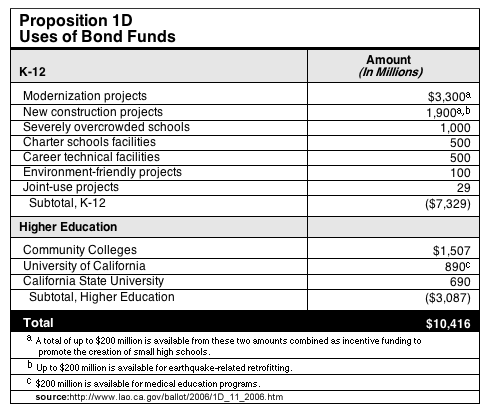What it does
Proposition 1D would authorize the state to sell $10.4 billion in bonds to build and repair public school facilities. The money would be used to repair older facilities and build new facilities at the K-12, California Community College, California State University and University of California systems. The money will also be used to improve earthquake safety and provide funding for vocational education facilities. The money is divided into $7.3 billion for K-12 school facilities and $3.1 billion for higher-education facilities.
According to the state Legislative Analyst's Office, the state costs will be approximately $680 million per year to pay off the bonds, including about $9.9 billion in interest. This brings the total cost of the bond to approximately $20 billion.
Why it is on the ballot
California has 6.3 million students spread out among 1,000 local school districts at the K-12 level and 2.1 million students in the public higher-education system, which includes the California Community College, California State University and University of California systems. In recent years, there has been rapid growth in the student populations throughout many districts in the state. Often, local and state revenues do not keep up with the demand for education facilities.
Pros
Those who support Proposition 1D claim:
- Since the Passage of Proposition 13, education in California has suffered severe declines in local revenue. Local communities no longer have the means to raise property taxes to improve schools. State bond financing has become one of the main ways schools receive sufficient funding to keep up with increasing demand.
- This proposition is necessary to upgrade more than 7,000 buildings to make them earthquake safe.
- The fast population growth throughout our state has resulted in severe overcrowding in many schools. This bond will provide funding to begin building new schools for the 1 million students in schools that have 75 percent more students than they were designed for. The bond will fund construction of 6,500 K-12 and 3,000 community college classrooms.
- Community colleges are one of California's great economic-development engines. Their budgets and classrooms are stretched too thin. They are already making efficient use of their facilities but need this money to make sure they have enough space overall.
Cons
Those who oppose Proposition 1D claim:
- The bond provides too much of a short-term fix by only funding the needs for the next two years.
- The bond requires a local match of 50 percent, which puts poorer districts at a disadvantage.
- We already have more than $100 billion in outstanding debt, yet tax revenues have grown by nearly 25 percent in recent years.
- We should look to ways to pay for schools other than debt financing. We could expand year-round schooling or make more efficient use of existing facilities without continuing the overcrowding.
- Instead of debt financing, we should implement a pay-as-you-go system for school bonds. This reduces the high interest costs to taxpayers.
SPUR's analysis
This bond would be used to fund a variety of measures for K-12 and higher education, including modernization, new construction, reductions in overcrowding, charter-school facilities and career technical facilities, as well as environment-friendly projects and joint-use projects.
The following details how the bonds will be used across these areas:

This money is essential to continue to provide substantial funding to our state's public schools. We see no serious downsides to this proposal. The big argument against the bond is really a wish that there could be more money. To that, we say some is better than none. Regarding the wish that we could fund school infrastructure on a pay-as-you-go basis instead of borrowing money through bonds, the same criticism applies to every bond and every type of borrowing for public infrastructure. We support these bonds because they are investments in our infrastructure that will yield positive economic and social returns.
SPUR recommends a "Yes" vote on Proposition 1D.